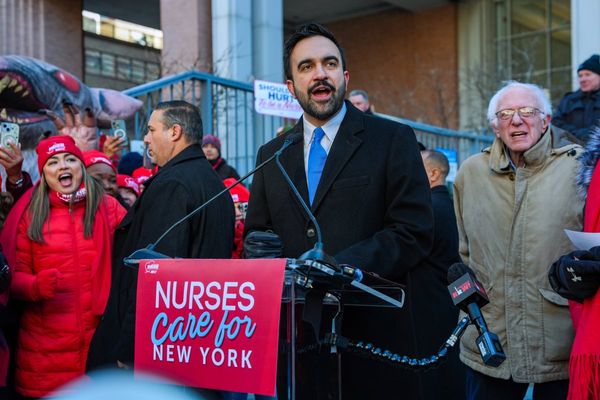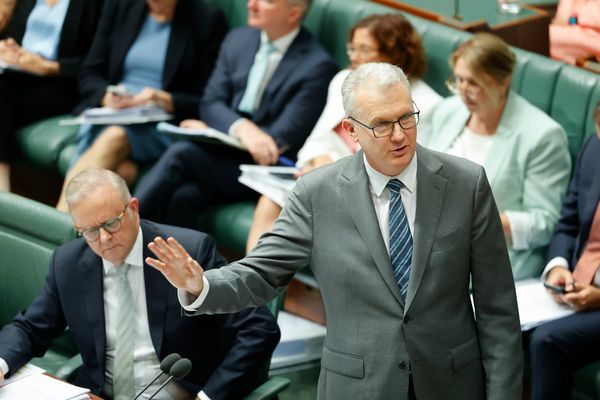
It is a folly to judge a book by its cover and, by the same logic, to dismiss a two-part documentary based on its title. Still, Living Next Door to Putin seems particularly egregious, evoking a wacky sitcom akin to the notoriously shortlived 1990 comedy Heil Honey I’m Home!, in which a Jewish couple find themselves living next door to Adolf Hitler and Eva Braun.
Instead of being a highly problematic farce, Living Next Door to Putin is an insightful, delicately handled portrait of eastern Europe’s anxieties and the ramifications of existing on the potential frontline of Vladimir Putin’s westward expansion. While Ukraine is engulfed in warfare not seen in Europe since the second world war, the journalist Katya Adler spends this two‑parter looking at the practical and existential impact this has on Poland, Lithuania, Latvia, Estonia, Finland and Norway.
Adler is a remarkable journalist and broadcaster who has been covering frontline news for more than 30 years and has been the BBC’s Europe editor since 2014. Her knowledge and integrity give the programme a sensitive intelligence. She investigates the contradictions of each country’s response with empathy and dignity, acknowledging how incredible it is that Poland has embraced 1.5 million refugees, and is able to cry and connect with a 75-year-old woman who fled Ukraine after two months of “hell”.
But Adler is not content simply to platform the understandable pride the Polish people have in opening their homes to fellow white, Catholic eastern Europeans; she contextualises it within the broader migration crisis that has seen less generosity afforded to others.
Belarus, an ally of Russia, has stoked rightwing sentiment to ramp up anti-immigrant rhetoric in Poland. While many Ukrainians have been met with open arms, Russia has been playing chess while others have been playing draughts, allowing a series of migrants to flow to Poland so that its hardline, anti-immigration government would become increasingly less sympathetic to Ukraine. Adler shows how it caused political turmoil by funnelling migrants from the Middle East, Africa and Asia across the Belarus border to distract from the potential creeping expansion from the Kremlin.
In a programme filled with brutality, the most upsetting sequences depict the plight of Sudanese refugees attempting to cross through the forest between Belarus and Poland. These people, who risk hypothermia in the woodland undergrowth, just want better lives. But unlike their Ukrainian counterparts, they are considered subhuman by much of the populace. Adler and a few activists risk their safety to bring them supplies. We see some huddled in the forest, grateful for water, food and medicine, while others are dragged illegally across the border by security forces, doomed to attempt this crossing time and time again with no hope of the warm welcome Ukrainians have received.
That is not to say the opinions on Ukraine are unanimous. There are but two hours to explain six countries’ histories and geopolitical relationships to Russia, but Adler is up to the challenge. Lithuania is shown to have its identity entangled with Ukraine. The country was among the first to seek independence from the Soviet Union, which colours its perspective on the conflict. On Lithuania’s independence day, they march past buildings scarred by the bullets of the 1991 conflict when the Soviet Union attempted to suppress its sovereignty; there are almost as many Ukrainian flags as Lithuanian ones. As Adler explains: “Solidarity with Ukraine mingles with national pride, shaped at least in part by Lithuania’s defiance of Moscow.”
It is only a short hop to Latvia to see how Russian identity bleeds across its borders. The country is about one-quarter ethnically Russian; in its second-largest city, Daugavpils, eight out of 10 people speak Russian at home. As the Ukraine conflict rages, Adler seems shocked to see Latvian citizens laying flowers at monuments to Russian soldiers. She makes the most of these moments, fascinated by the complex contradictions of the region.
The second episode, to be broadcast on 19 September, looks at the reactions of Estonia, Finland and Norway. It is slightly more playful than the first. Adler meets beluga whales suspected of spying, travels in hot-air balloons, learns the importance of saunas on the frontline and meets Finland’s reservists, who have the courage of their convictions, but come across as role-players ill-equipped to take on a much larger power.
Still, beyond the Norwegians – who, Adler explains, seem unique in “trying to send a message of calm to their Russian neighbours” – Putin’s neighbours are willing to do whatever is necessary to ensure the outcome they desire.
This documentary provides a stark portrait of a region in which the paradigm has shifted, old wounds have been reopened and tensions run high. It is an unenviable situation to be “Putin’s neighbour”, but the ramifications of his expansionism could have dire global consequences.
• Episode two of Living Next Door to Putin is on BBC One on 19 September. Episode one is on BBC iPlayer







